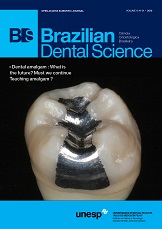Intra pulp chamber temperature variation caused by Nd:YAG and Diode LASER irradiation
DOI:
https://doi.org/10.14295/bds.2015.v18i1.1086Abstract
Objective: Neodymium (Nd:YAG) and Diode LASER irradiation on adhesive systems canincrease bond strength to dentin, however, concerns about the temperature variation inside pulp chamber still remain. The aim of this study was to evaluate the intra pulp chamber temperature variation caused by irradiation with Nd:YAG or Diode LASER on different adhesive systems. Material and Methods: This study presented experimental design with two factors: LASER on two levels (Diode [D] and Nd:YAG [N]) and adhesive system on four levels (Adper™ Scotchbond™ Multi-Purpose [MP], Adper™ SingleBond 2 [SB], Clearfil™ SE Bond [CSE] and Adper™ Easy One [EO]). The quantitative response variable was the temperature variation (?t) in C. Forty bovine teeth, distributed into 8 groups (n = 5), had the buccal surface flattened up to1 mm thickness of dentin. After the application of each adhesive system, but previously to the light curing, specimens were irradiated with Nd:YAG or Diode LASER with standardized parameters. The ?t was obtained through a thermocouple inserted into pulp chamber. The values of ?t were submitted to two-way ANOVA, followed by Tukey (p < 0.05) for individual comparisons. Results: The means (± standard deviation) of ?t were: N-MP: 12.60 (± 2.51), N-SB: 10.40 (± 5.03), N-CSE: 11.80 (± 5.12) and N-EO: 10.20 (± 2.39), D-MP: 4.4 (± 1.82), D-SB: 5.20 (± 1.54), D-CSE: 4.60 (± 1.14), D-EO: 3.60 (± 1.52). Conclusion: The type of adhesive system was not significant in temperature changes generated by LASER irradiation, but Nd:YAG LASER may provide a higher potential to cause pulp damage.
Downloads
Downloads
Additional Files
Published
How to Cite
Issue
Section
License
Brazilian Dental Science uses the Creative Commons (CC-BY 4.0) license, thus preserving the integrity of articles in an open access environment. The journal allows the author to retain publishing rights without restrictions.
=================




























